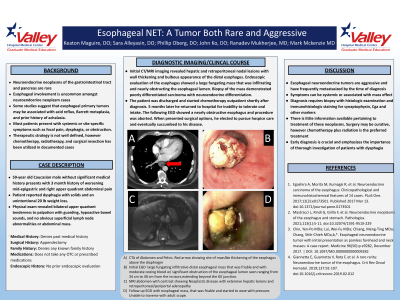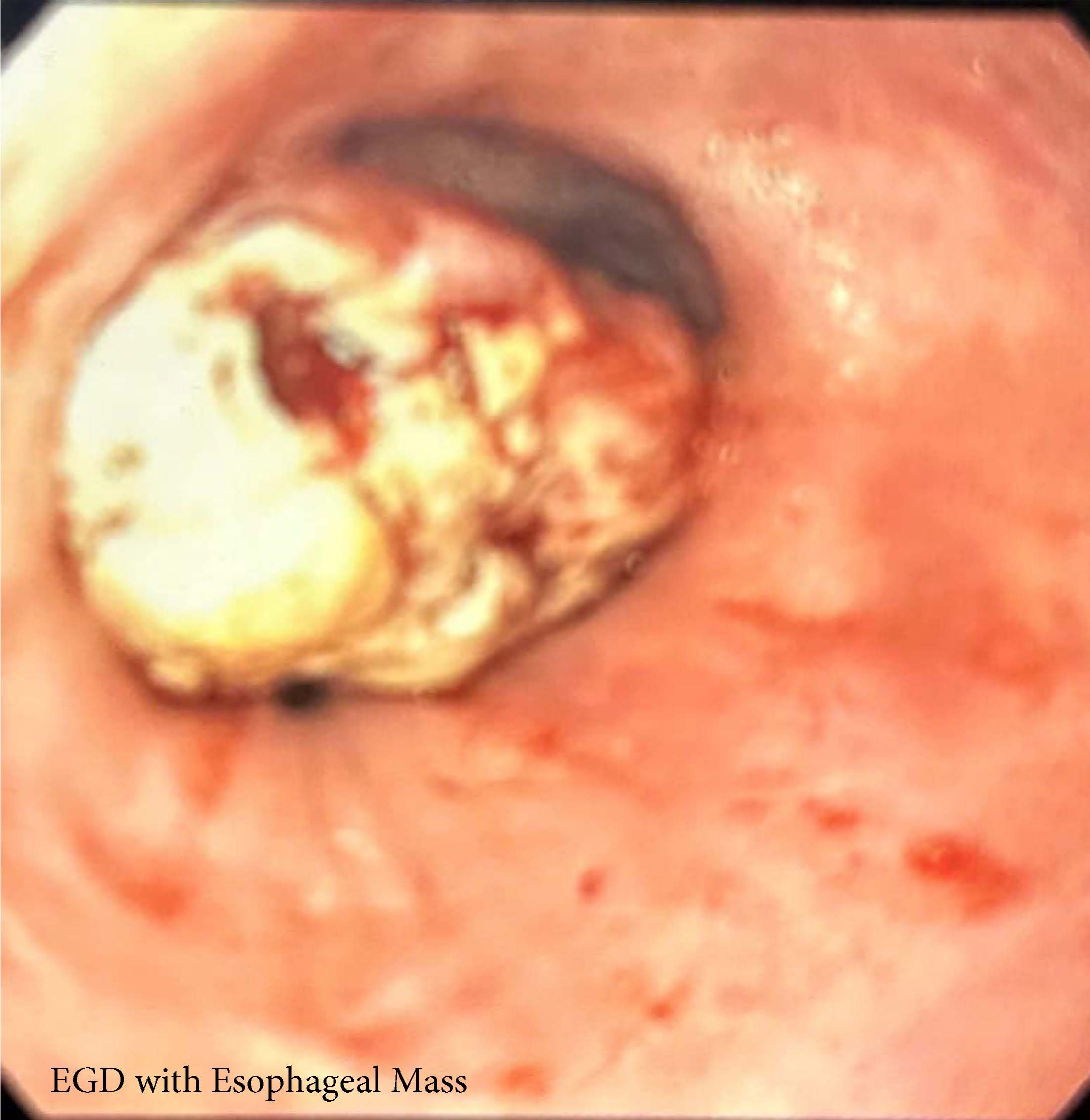Monday Poster Session
Category: Esophagus
P1908 - Esophageal NET: A Tumor Both Rare and Aggressive
Monday, October 23, 2023
10:30 AM - 4:15 PM PT
Location: Exhibit Hall

Has Audio
- KM
Keaton Maguire, DO
Valley Hospital Medical Center
Las Vegas, Nevada
Presenting Author(s)
Keaton Maguire, DO1, Sara Alleyasin, DO1, Phillip Oberg, DO1, John Ko, DO1, Mark McKenzie, MD2, Ranadev Mukherjee, MD3
1Valley Hospital Medical Center, Las Vegas, NV; 2VHMC GME, Las Vegas, NV; 3Digestive Associates, Las Vegas, NV
Introduction: Neuroendocrine neoplasms of the gastrointestinal tract and pancreas are considered a rare group of malignancies, and esophageal involvement is even less common. Risk factors for neuroendocrine neoplasms are not well known, however, some studies suggest that esophageal primary tumors may be associated with acid reflux, Barrett metaplasia, and prior history of achalasia. Most patients present with systemic or site-specific symptoms such as focal pain, dysphagia, or obstruction. We discuss a case of a male who presents with abdominal pain and dysphagia in the setting of obstructing esophageal neoplasm.
Case Description/Methods: 59-year old Caucasian male without significant medical history presents with mid-epigastric and right upper quadrant abdominal pain that had been worsening over the previous 3 months. Patient reported associated dysphagia with solids and an unintentional 20 lb weight loss. Physical exam revealed bilateral upper quadrant tenderness to palpation with guarding, hypoactive bowel sounds, and without obvious superficial lymph node abnormalities or abdominal mass. CT imaging revealed hepatic and retroperitoneal nodal lesions with wall thickening and bulbous appearance of the distal esophagus. Endoscopic evaluation of the esophagus showed a large fungating mass that was infiltrating and nearly obstructing the esophageal lumen. Biopsy of the mass demonstrated poorly differentiated carcinoma with neuroendocrine differentiation. The patient started chemotherapy outpatient shortly after diagnosis, nevertheless after 5 months he returned to hospital for inability to tolerate oral intake. The following EGD showed a nearly obstructive esophagus and procedure was aborted. When presented surgical options, he elected to pursue hospice care and eventually succumbed to his disease.
Discussion: Esophageal neuroendocrine tumors are aggressive and have frequently metastasized by the time of diagnosis. Symptoms can be systemic or associated with mass effect. Diagnosis requires biopsy with histologic examination and immunohistologic staining for synaptophysin, Cga and other markers. There is little information available pertaining to treatment of these neoplasms. Surgery may be curative, however chemotherapy plus radiation is the preferred treatment. Early diagnosis is crucial and emphasizes the importance of thorough investigation of patients with dysphagia. The purpose of this case report is to encourage continued research and reporting of such cases along with the effectiveness of treatment.

Disclosures:
Keaton Maguire, DO1, Sara Alleyasin, DO1, Phillip Oberg, DO1, John Ko, DO1, Mark McKenzie, MD2, Ranadev Mukherjee, MD3. P1908 - Esophageal NET: A Tumor Both Rare and Aggressive, ACG 2023 Annual Scientific Meeting Abstracts. Vancouver, BC, Canada: American College of Gastroenterology.
1Valley Hospital Medical Center, Las Vegas, NV; 2VHMC GME, Las Vegas, NV; 3Digestive Associates, Las Vegas, NV
Introduction: Neuroendocrine neoplasms of the gastrointestinal tract and pancreas are considered a rare group of malignancies, and esophageal involvement is even less common. Risk factors for neuroendocrine neoplasms are not well known, however, some studies suggest that esophageal primary tumors may be associated with acid reflux, Barrett metaplasia, and prior history of achalasia. Most patients present with systemic or site-specific symptoms such as focal pain, dysphagia, or obstruction. We discuss a case of a male who presents with abdominal pain and dysphagia in the setting of obstructing esophageal neoplasm.
Case Description/Methods: 59-year old Caucasian male without significant medical history presents with mid-epigastric and right upper quadrant abdominal pain that had been worsening over the previous 3 months. Patient reported associated dysphagia with solids and an unintentional 20 lb weight loss. Physical exam revealed bilateral upper quadrant tenderness to palpation with guarding, hypoactive bowel sounds, and without obvious superficial lymph node abnormalities or abdominal mass. CT imaging revealed hepatic and retroperitoneal nodal lesions with wall thickening and bulbous appearance of the distal esophagus. Endoscopic evaluation of the esophagus showed a large fungating mass that was infiltrating and nearly obstructing the esophageal lumen. Biopsy of the mass demonstrated poorly differentiated carcinoma with neuroendocrine differentiation. The patient started chemotherapy outpatient shortly after diagnosis, nevertheless after 5 months he returned to hospital for inability to tolerate oral intake. The following EGD showed a nearly obstructive esophagus and procedure was aborted. When presented surgical options, he elected to pursue hospice care and eventually succumbed to his disease.
Discussion: Esophageal neuroendocrine tumors are aggressive and have frequently metastasized by the time of diagnosis. Symptoms can be systemic or associated with mass effect. Diagnosis requires biopsy with histologic examination and immunohistologic staining for synaptophysin, Cga and other markers. There is little information available pertaining to treatment of these neoplasms. Surgery may be curative, however chemotherapy plus radiation is the preferred treatment. Early diagnosis is crucial and emphasizes the importance of thorough investigation of patients with dysphagia. The purpose of this case report is to encourage continued research and reporting of such cases along with the effectiveness of treatment.

Figure: EGD with Esophageal Tumor
Disclosures:
Keaton Maguire indicated no relevant financial relationships.
Sara Alleyasin indicated no relevant financial relationships.
Phillip Oberg indicated no relevant financial relationships.
John Ko indicated no relevant financial relationships.
Mark McKenzie indicated no relevant financial relationships.
Ranadev Mukherjee indicated no relevant financial relationships.
Keaton Maguire, DO1, Sara Alleyasin, DO1, Phillip Oberg, DO1, John Ko, DO1, Mark McKenzie, MD2, Ranadev Mukherjee, MD3. P1908 - Esophageal NET: A Tumor Both Rare and Aggressive, ACG 2023 Annual Scientific Meeting Abstracts. Vancouver, BC, Canada: American College of Gastroenterology.
